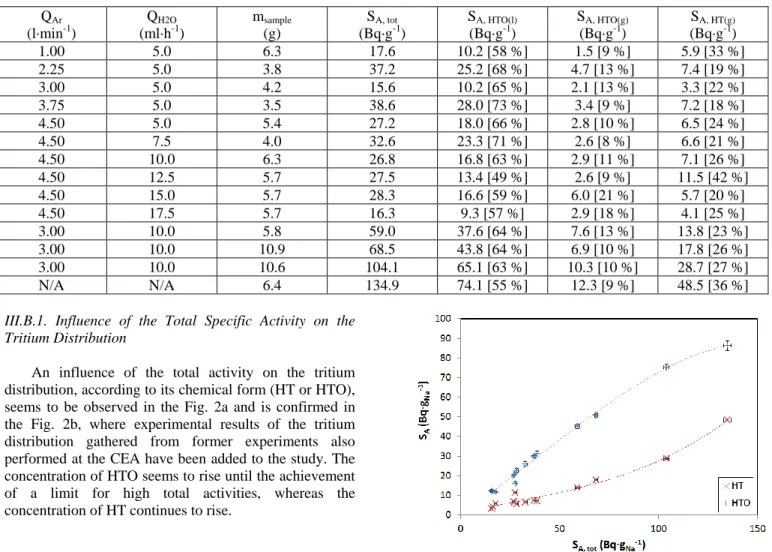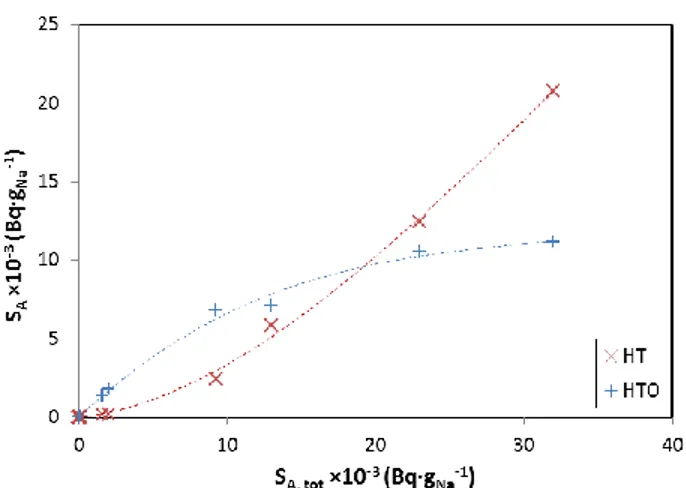http://dx.doi.org/10.13182/FST14-T15
EXPERIMENTAL STUDY OF THE TRITIUM DISTRIBUTION IN THE EFFLUENTS RESULTING FROM THE
SODIUM HYDROLYSIS
Aurelien Chassery,
a, b, c, *Helene Lorcet,
aJoel Godlewski,
aKarine Liger,
aChristian Latge,
aXavier Joulia
b,ca
CEA, DEN, Cadarache, DTN, F-13108 Saint-Paul-Lez-Durance, France ;
b
Université de Toulouse ; INPT, UPS ; Laboratoire de Génie Chimique ; 4, Allée Emile Monso, F-31030 Toulouse, France ;
c
CNRS ; Laboratoire de Génie Chimique ; F-31030 Toulouse, France.
* aurelien.chassery@cea.fr
Within the framework of the dismantling of fast
breeder reactors in France (PHENIX, SUPERPHENIX,
RAPSODIE), several processes are under investigation
regarding sodium disposal. One of them, called ELA
(radioactive sodium waste treatment process), is based on
the implementation of the sodium-water reaction, in a
controlled and progressive way, to remove residual
sodium mainly from the sodium purification systems
called cold traps. This sodium contains impurities such as
sodium hydride, sodium oxide and tritiated sodium
hydride. The hydrolysis of these various chemical species
leads to the production of a liquid effluent, mainly
composed of an aqueous solution of sodium hydroxide,
and a gaseous effluent, mainly composed of nitrogen
(inert gas), hydrogen and steam. The tritium is distributed
between these effluents, and, within the gaseous effluent,
according to its forms HT and HTO. HTO being 10,000
times more radiotoxic than HT, a precise knowledge of
the mechanisms governing the phase distribution of
tritium is necessary. Indeed, it will help to design the
process needed to optimize the treatment of the off-gas
before its release into the environment.
This paper presents the first experimental results
from a parametric study on the tritium distribution
between the various effluents generated during hydrolysis
operations. This parametric study has been performed in
a laboratory scale hydrolysis process designed at the
CEA Cadarache.
I. INTRODUCTION
Liquid sodium, used as a coolant fluid in Sodium
Fast Breeder Reactors (SFBR), can contain several
impurities such as oxygen or hydrogen, present from the
start or introduced during certain servicing or handling
operations on components or fuel assemblies. Another
contaminant that can be found in the sodium is the
tritium, a radioactive hydrogen isotope, mainly produced
by fission reactions. In order to operate in safe conditions,
the sodium is purified in devices called cold traps, in
which the crystallization of the sodium oxide (Na
2O),
sodium hydride (NaH) and co-crystallization of tritiated
sodium hydride (NaT) is induced by cooling. The crystals
thus formed are trapped on a woven steel wool support.
When these devices need to be dismantled, the residual
sodium and impurities must be removed.
Various methods have been proposed or developed in
the past to remove residual sodium from cold traps.
1One
of them rests on the implementation of the sodium-water
reaction (SWR) to remove films or clusters of residual
sodium. As described in previous paper (Ref. 2), this
reaction is
almost instantaneous,highly exothermic
aand is
characterized by the generation of large volumes of
hydrogen gas and the production of soda.
) ( , 2 ) ( ) ( 2 ) (
2
1
g s l sH
O
NaOH
H
Na
(1)
) ,( 2 ) ( ) ( 2 ) (sH
O
lNaOH
sH
gNaH
(2)
) ( ) ( 2 ) ( 2O
sH
O
l2
NaOH
sNa
(3)
) ( ) ( ) ( aq aq water sNa
OH
NaOH
(4)
In order to use these reactions in a controlled and
progressive way, a process called ELA (Enceinte de
Lavage en Actif), is under development mainly for the
cleaning of cold traps from the prototype fast breeder
reactor PHENIX. This process is continuously controlled
by limiting the water flow rate in the vessel to avoid over
pressure, hydrogen and temperature excursions.
In order to design the process, a precise knowledge of
the composition of the effluents is needed. Indeed, the
a


